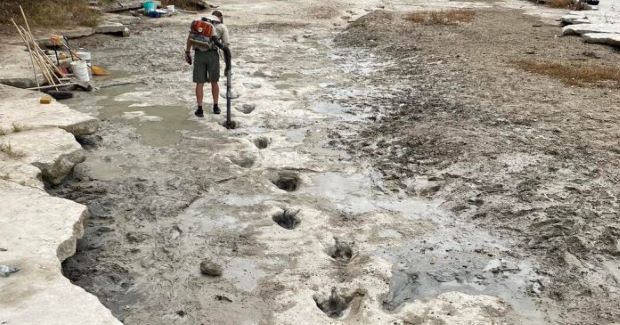The latest find as water levels fall: Dinosaur tracks in Texas
By April Rubin
As a punishing drought grips parts of the world this summer, bodies of water have been drying up, exposing submerged World War II relics in Europe, several sets of human remains at Lake Mead outside Las Vegas, and even an entire village in Spain.
The latest find as water levels fall: dinosaur tracks in Texas.
Severe drought conditions at Dinosaur Valley State Park, about 60 miles southwest of Fort Worth, exposed dinosaur tracks from around 113 million years ago that were previously hidden underneath the Paluxy River, according to Stephanie Garcia, a spokesperson for the Texas Parks and Wildlife Department. The tracks, which were discovered this month, belong to Acrocanthosaurus, which are theropods, or bipedal dinosaurs with three toes and claws on each limb.
The dinosaur would have stood 15 feet tall and weighed close to 7 tons as an adult. They would have left their tracks in sediment that hardened into what is now limestone, researchers say.
“Due to the excessive drought conditions this past summer, the river dried up completely in most locations, allowing for more tracks to be uncovered here in the park,” Garcia said in a statement. “Under normal river conditions, these newer tracks are under water and are commonly filled in with sediment, making them buried and not as visible.”
The tracks are likely to be buried again by rain this week. But the finding — even if for a brief moment — excited researchers and the public.
“Tracks being buried under layers of sediment do help protect them from natural weathering and erosion,” Garcia said.
Other tracks at Dinosaur Valley State Park belong to a sauropod, or long-necked, small-headed dinosaur, called Sauroposeidon proteles. This species would have stood 60 feet tall and weighed 44 tons as an adult.
Louis Jacobs, a vertebrate palaeontologist and an emeritus professor of earth sciences at Southern Methodist University, saw the tracks Saturday. He said these uncovered tracks joined trackways that were already known, and they now add up to about 150 dinosaur steps.
“Those footprints — they’re spectacular because they’re deep,” he said. “You can see the toenails. There’s more than one kind, and there’s a lot of them.”
Jacobs said the prints signalled there might be more that remained undiscovered. As the river erodes, it will expose more but also erase some others.
Dinosaur tracks collected from the Paluxy River in 1938 are on display at the American Museum of Natural History in New York City.
Similar tracks have been found in British Columbia and South America, said James Farlow, a vertebrae palaeontologist and adjunct biology professor at Purdue University Fort Wayne.
The river and park have been educating researchers on dinosaur behaviour for decades, he said. But the discoveries are often at the mercy of weather, including freezing rocks in the winter cracking the tracks.
The footprints occur on a sedimentary rock unit called the Glen Rose Formation, which is mostly limestone, deposited about 105 to 110 million years ago, Farlow said.
“Texas is blessed with a lot of good fossil occurrences,” Farlow said, “not only of dinosaur footprints but also of dinosaur skeletons as well.”
He added, “It’s a resource that is continually being destroyed but continuously being renewed.”
Texas is facing extreme weather, with parts of the state experiencing droughts and other parts seeing flash flooding, following a period of intense heat and dangerous wildfire.
Some parts of the Dallas-Fort Worth area saw more than 13 inches of rain Sunday into Monday, leading Judge Clay Jenkins of Dallas County, the top elected official there, to declare a state of disaster in the region. Gov. Greg Abbott directed the Texas Division of Emergency Management to mobilize resources to help residents affected by the flooding.
The drought has triggered water restrictions in Texas, including 27% of the state that is under the most severe category of drought warning.
Scientists call a rapid shift from extreme dry to extreme wet conditions “precipitation whiplash.”
-New York Times



Comments are closed, but trackbacks and pingbacks are open.